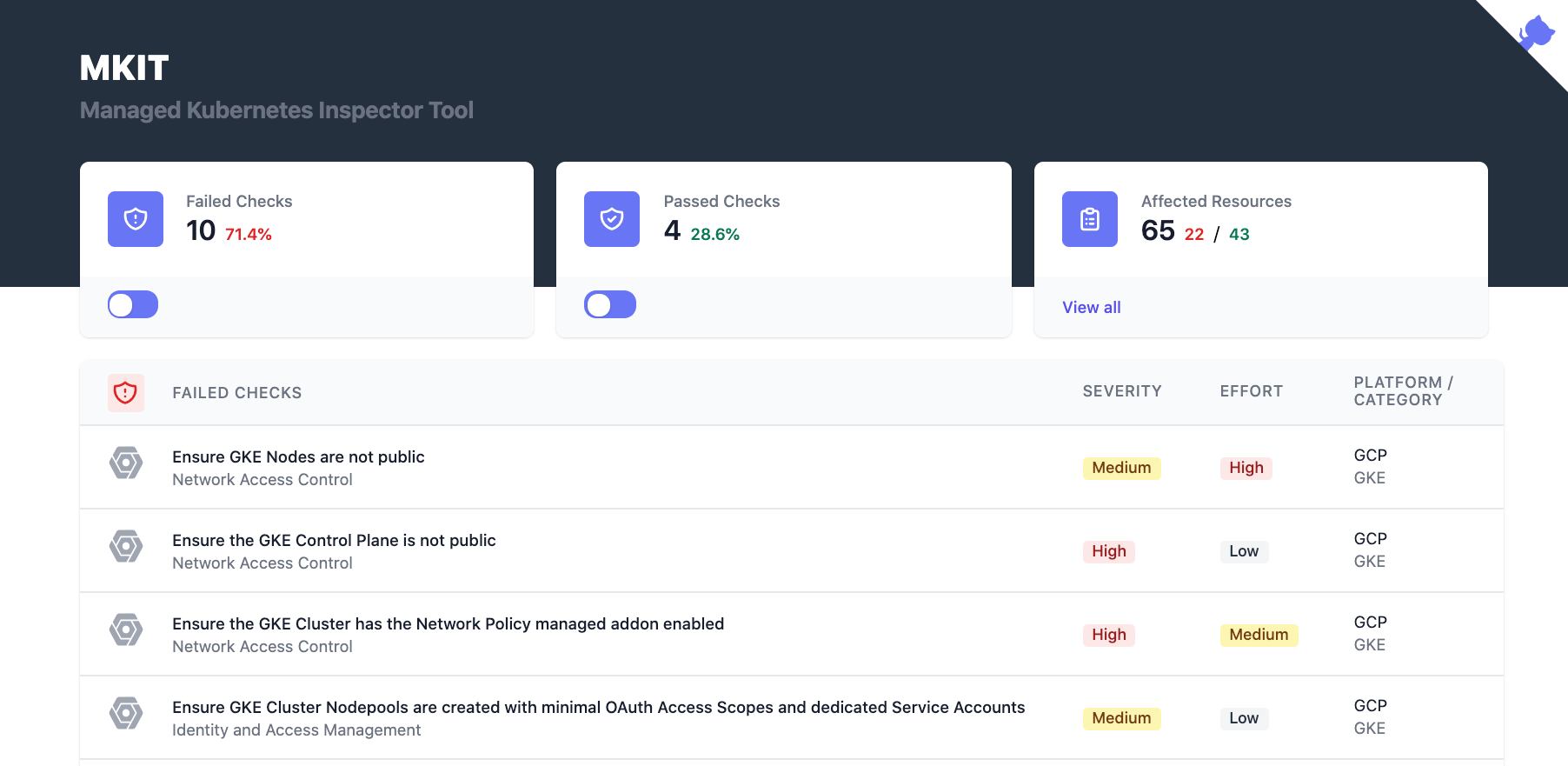darkbitio / Mkit
Projects that are alternatives of or similar to Mkit
MKIT - Managed Kubernetes Inspection Tool
Quickly discover key security risks of your managed Kubernetes clusters and resources
MKIT is a Managed Kubernetes Inspection Tool that leverages FOSS tools to query and validate several common security-related configuration settings of managed Kubernetes cluster objects and the workloads/resources running inside the cluster. It runs entirely from a local Docker container and queries your cloud provider's APIs and the Kubernetes API to determine if certain misconfigurations are found. The same Docker container then launches a web UI to view and navigate the results on localhost:8000.
Demo
View a live demo of the web UI here.
- Who is MKIT for?
- What does it check?
- What is it doing?
- Viewing Results
- Quick Start
- Building Local
- Development
Who is this for?
MKIT provides security-minded Kubernetes cluster administrators with a quick way to assess several common misconfigurations in their Kubernetes environment.
Which Managed Kubernetes providers are supported?
- Azure Kubernetes Service (AKS)
- Amazon Elastic Kubernetes Service (EKS)
- Google Kubernetes Engine (GKE)
Note: Authenticating to AKS-Engine clusters using Azure for AD is not yet supported. For now, ensure your kubeconfig entry is generated using az aks get-credentials.
What if I'm running Kubernetes not on AKS, EKS, or GKE?
You can run the in-cluster Kubernetes checks by themselves. See the steps for targeting k8s instead of aks, eks, or gke.
What does MKIT check for?
MKIT makes use of Chef Inspec-formatted profiles, and they are located at the locations below:
- https://github.com/darkbitio/inspec-profile-aks
- https://github.com/darkbitio/inspec-profile-eks
- https://github.com/darkbitio/inspec-profile-gke
- https://github.com/darkbitio/inspec-profile-k8s
What does it do?
When running make with various parameters, the MKIT tool is leveraging your credentials to query the cloud provider's APIs for the specific cluster and validating its configuration. It then connects to the cluster directly via the Kubernetes API server to validate several configuration items inside the cluster. Finally, it combines those results into a format viewable by the mkit-ui launched inside the mkit container listening on http://localhost:8000 for viewing.
Sensitive Data
All results are stored inside the container for the life of that MKIT run, and they are not uploaded or shared in any way.
Viewing Results
The MKIT web UI (http://localhost:8000) shows all of the results on a single page. Failed checks appear first, followed by passed checks. Clicking view all will show all of the underlying resources impacted by the checks and whether they passed or failed.
Quick Start
- Clone this repository to your Linux / macOS / WSL2 system.
- See the section on building the image manually, if desired.
- Ensure you have the permissions to
get/list/describeyour cluster via the native APIs and you have Kubernetescluster-adminor theviewClusterRolebound to your current account. - Run the tool for your use case:
AKS
Export your Azure credentials as local environment variables. The following are required:
AZURE_CLIENT_IDAZURE_TENANT_IDAZURE_CLIENT_SECRETAZURE_SUBSCRIPTION_ID
Run with the AKS option:
make run-aks resourcegroup=myResourceGroup clustername=my-aks-cluster-name
EKS
Export your AWS credentials as local environment variables. The following are required:
AWS_PROFILEAWS_ACCESS_KEY_IDAWS_SECRET_ACCESS_KEY
Run with the EKS option:
make run-eks awsregion=us-east-1 clustername=my-eks-cluster-name
GKE
Authenticate with your Google Cloud credentials
gcloud auth application-default login
Run with the GKE option (be sure to specify project-id and not project-name):
make run-gke project_id=my-project-id location=us-central1 clustername=my-gke-cluster-name
Standalone Kubernetes
Ensure the current context is set in your KUBECONFIG (~/.kube/config) file. Confirm access and that the proper cluster is being targeted.
kubectl get nodes
Run with the standalone Kubernetes option.
make run-k8s
Visit http://localhost:8000 to view the results of the scan.
Note: the k8s profile checks are automatically run by the aks, eks, and gke invocations. You would only need to run the k8s checks separately if you don't have access to or want to review the cluster and node configurations.
Example run against an AKS cluster
$ make run-aks resourcegroup=myResourceGroup clustername=aks1
Running in darkbitio/mkit:latest: /home/node/audit/aks.sh
Generating results...[2020-03-26T22:33:45+00:00] WARN: Overwriting resource azurerm_resource. To reference a specific version of azurerm_resource use the resource() method
[2020-03-26T22:33:45+00:00] WARN: Overwriting resource azurerm_aks_cluster. To reference a specific version of azurerm_aks_cluster use the resource() method
done.
Merged "aks1" as current context in /home/node/.kube/config
Generating results...done.
Visit http://localhost:8000 to view the results
yarn run v1.22.0
node app.js
MKIT Running - browse to http://localhost:8000
Example run against an EKS cluster
$ make run-eks awsregion=us-east-1 clustername=eks1
Generating results...done.
Added new context arn:aws:eks:us-east-1:1234567890:cluster/eks1 to /home/node/.kube/config
Generating results...done.
Visit http://localhost:8000 to view the results
yarn run v1.22.0
node app.js
MKIT Running - browse to http://localhost:8000
Example run against a GKE cluster
$ make run-gke project_id=my-gke-project location=us-central1 clustername=my-gke-cluster
Running in darkbitio/mkit:latest: /home/node/audit/gke.sh
Generating results...done.
Fetching cluster endpoint and auth data.
kubeconfig entry generated for my-gke-cluster.
Generating results...done.
Visit http://localhost:8000 to view the results
yarn run v1.22.0
node app.js
MKIT Running - browse to http://localhost:8000
Example run against a standalone cluster
Run again a standalone cluster (e.g. Docker Desktop).
$ make run-k8s
Running in darkbitio/mkit:latest: /home/node/audit/k8s.sh
Generating results...done.
Visit http://localhost:8000 to view the results
yarn run v1.22.0
node app.js
MKIT Running - browse to http://localhost:8000
Building Local
If you prefer to build the Docker images locally before running, the Dockerfile is in this repo.
Building the Docker image manually
- Clone this repo
- Modify the Makefile to name the image as desired
- Run
make buildto build the container from scratch
Development
We welcome any contributions from users in the community.
Customizing/Extending the checks
- Fork the desired profile repository
- Modify the release tag and release URL to point to your new repository/release
- Follow the steps in the previous section to build a custom container using your new profile




